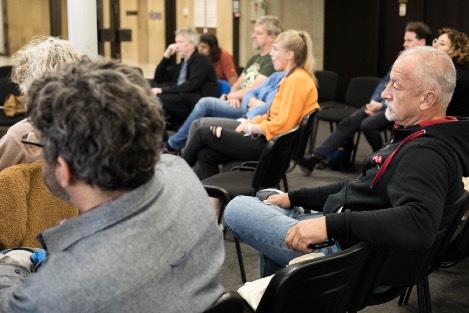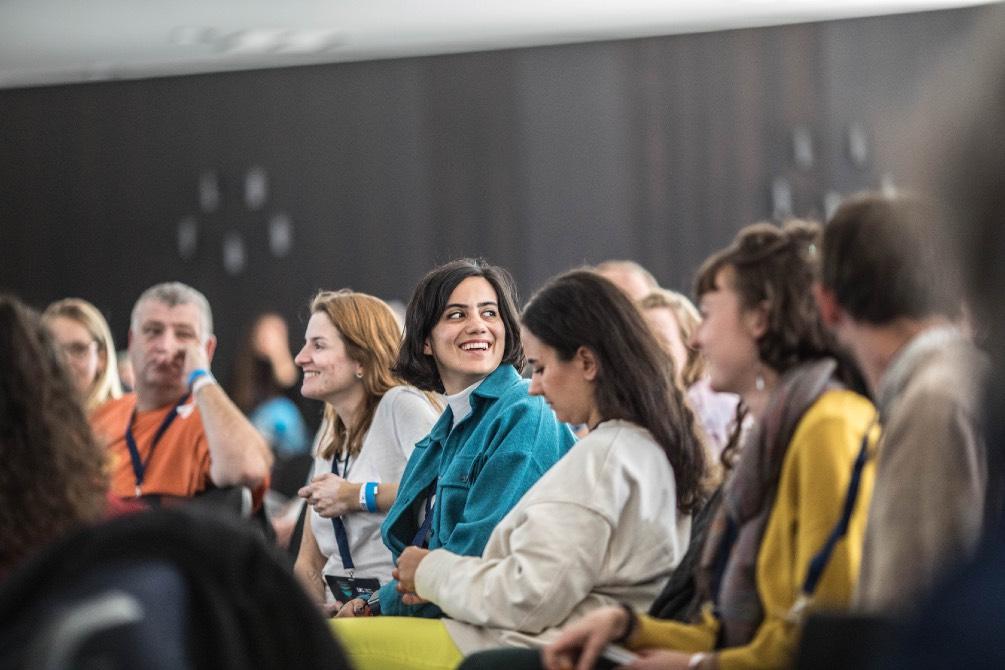
6 minute read
Gender Balance
With: Aneta Norek (Film and Jazz Music Foundation, PL) & Agnete Seerup (JazzDanmark, DK) Moderator: Maria Pia de Vito (artist and artistic director, IT)
This panel was moderated by Maria Pia de Vito, artist and artistic director from Italy. It was initially supposed to focus on the differences in gender balance between Eastern and Western Europe, but since Bulgarian speaker Mihaela Georgieva was ill, presentations were instead made by EJN members from Poland and Denmark.
Advertisement
The first speaker was Aneta Norek from the Film and Jazz Music Foundation in Krakow, Poland, who organise the International Contest of Young Jazz Ensembles Jazz Juniors. Founded in 1976, the competition has always been strongly entwined with the history of Polish jazz, since it is at the Jazz Juniors where some of the most famous Polish artists jazz artists made their first steps.
Jazz Juniors includes both a competition and workshops. Aneta said that interestingly, most of the participants for the workshops are girls. But in the competition, most are boys. Aneta said that the feedback she got from girls in the workshops was that they were too shy to enter the competition, they felt that they were not good enough etc. Even the girls who do enter the competition, you could hear this doubt. However, there was no such doubt from the boys. the Jazz Juniors is international, so Aneta believes it not only a Polish issue. In the 46 years history of the competition, only 2 girls have ever won.
Aneta said that this is specifically an issue in jazz - she has a classical music background and found that it was never a problem for her as a woman playing classical music. Aneta only began to doubt herself when she started playing jazz because due to its improvisational nature, a certain level of confidence and openness is required in jazz. Aneta added that jazz education exists in Poland, for example there are 8 jazz departments in different musical academies, but the majority of these students are boys.
The question came up about role models: would having successful female jazz musicians help girls have more confidence? Francesca, a staff member of the EJN said that currently the EJN is implementing a new project with Brussels-based Association Européenne des Conservatoires, to publish online profiles of successful women in music — not only musicians but also backstage crew, leaders, production, admin etc. They also plan to organise webinars and mentoring sessions for students from the conservatoires.
Then Agnete Seerup from JazzDanmark in Denmark gave a presentation. JazzDanmark supports and promotes Danish jazz, both within Denmark and abroad through the creation and development of new collaborations, partnerships, projects, and experiences and by encouraging

participation and awareness. Their social inclusion projects are EU funded: improvisation for asylum kids, jazz camp for girls, musikdata.dk.
Agnete then went on to present the report JazzDanmark commissioned around the question: Why are women grossly underrepresented in the music industry? 6,000 musicians and composers filled in a survey, 1,500 wrote about their individual stories, 17 interviews were conducted across the music industry, and a comprehensive literary study on the subject was done; in order to study the consequence of gender for performing musicians and composers.
The main conclusions of the report included:
Unregulated working conditions are very hard specifically for women The use of private networks are intertwined with professional networks. This seems crucial to obtain a career — yet women experience being excluded from these private networks. Furthermore, insufficient labour rights hit women harder i.e. in relation to maternity leave, sick leave, retirement etc. Lastly, women experience prejudices related to the idea that “working with female artists makes it harder to earn money” i.e. that they are not as financially lucrative as men
Prejudice overshadows the recognition of women and non-cisgendered There are stereotypical notions and biases about what women need to be able to succeed, negatively affecting the assessment of their musical abilities. More than one in three women and almost half of the non-gendered stated that they found their gender and appearance have a high or very high degree of significance for the assessment of their abilities.
Boundary violations / crossings are ubiquitous for women and non-gendered Within the last five years, 70% the non-cisgendered, 64% of women and 44% of men in the study experienced one or more forms of intimidating behaviour in their work as composers and performers. Furthermore, 16% of women reported being paid less compared to 8% of men. What to do about all this? Agnete stated that we need to focus on actions. We have enough knowledge, enough dialogue and enough good intentions. Now we need concrete actions, such as unconscious bias training.
“If you have a brain, you have unconscious bias.” JazzDanmark provides resources, courses and training to organisations on understanding what is unconscious bias and acting differently. The training aims at addressing our unconscious biases and working to improve inclusion and balance in art and culture.
Use of a blind hiring process is also an action that can be taken, to encourage the hiring of people from a more diverse range of backgrounds and to undermine the unconscious bias we all have. Removing personal information from candidate applications during the assessment process and asking only relevant questions is key!
Jazz Danmark also organise a Jazz Camp for Girls. 10 camps per year in summer since 2014, in collaboration with music schools. These camps also occur in Sweden, Finland and Poland.

Improvisation is a fundamental part of the Jazz Camp for Girls; it is instrumental to building their confidence, because confidence is key to improvisation. Improvisation also helps group flow and collaboration, where they can learn together, but also goes against the idea that there is a ‘right’ or ‘wrong’ way. This increases the girls’ tolerance of uncertainty and empowers them to make their own music regardless of experience.
Agnete mentioned Charles Limb, a surgeon, professor and music aficionado, who showed that during improvisation, the parts of the brain associated with self-expression are highly active, whereas parts involved with self-monitoring quiet down, enabling a dampening of inhibitions and better access to creativity. Having a Jazz Camp for Girls also raises awareness about gender balance in the music industry.
Group discussion reflected on how the professionalisation of jazz in conservatoires helped girls, allowed them to study jazz. Moderator Maria talked about how her father in Italy felt better that this was something she was studying in conservatoires, giving it legitimacy, rather than just in clubs or venues. The institutionalisation of jazz has made it more accessible to girls, but they need more living role models, who can also be their peers, as well as revising the history of jazz. The group discussed the fact that the history of jazz is not neutral, based as it is on a European history of music where women are hidden or not mentioned.
The group concluded that change is happening but very slowly. We need structures to change, to be stronger, so that jazz is attractive to girls and women. But it also reflects a deeper societal problem: the jazz industry will change only when our society changes.
The group suggested that JazzDanmark organise unconscious bias training for EJN members, especially training on how to apply it to each member’s organisation. They could also conduct a workshop at next year’s conference.









